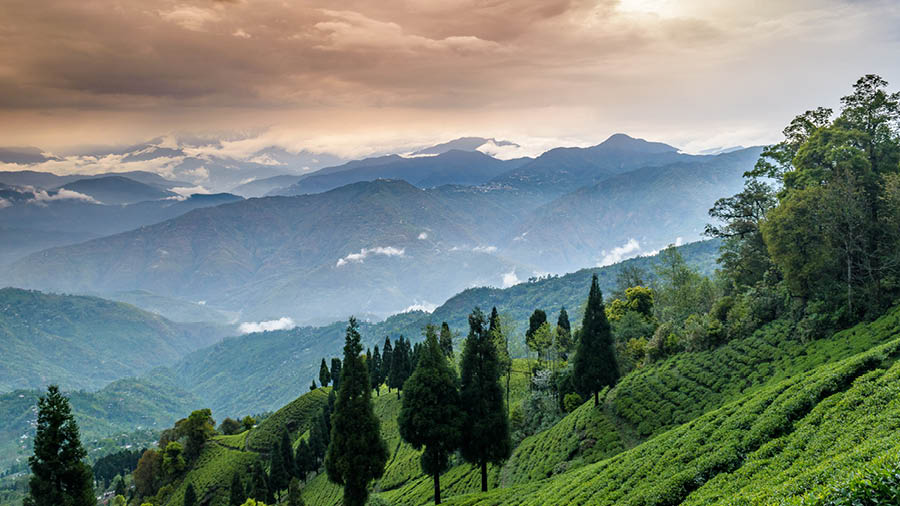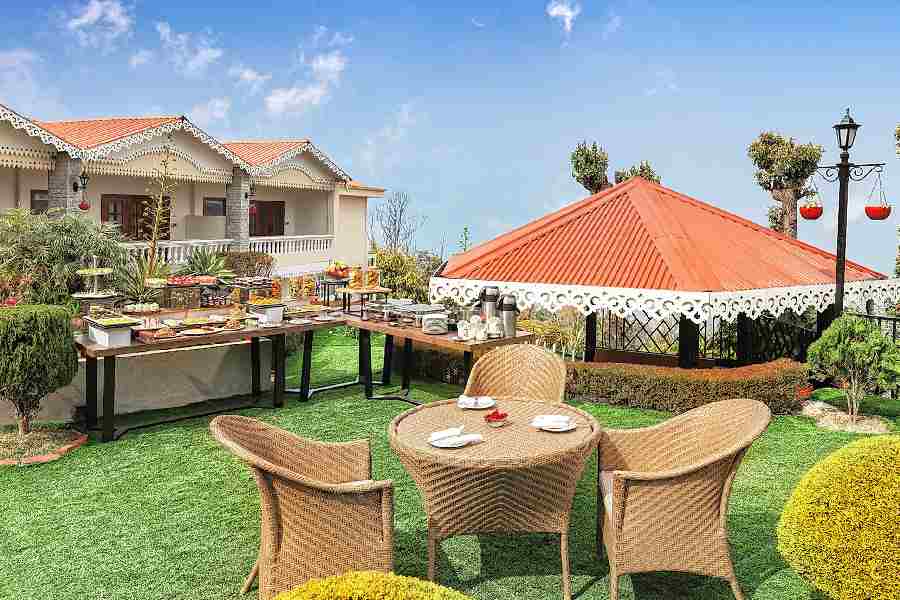As you approach Algarah town from Kalimpong, a cautionary sign board reminds you to navigate carefully due to sinking zones ahead. The optimal seasons for exploration are pre-monsoon and winter. The route from Algarah meanders towards Pedong, continuing through Rishi Khola and further into Sikkim, leading to the enchanting Silk Route.
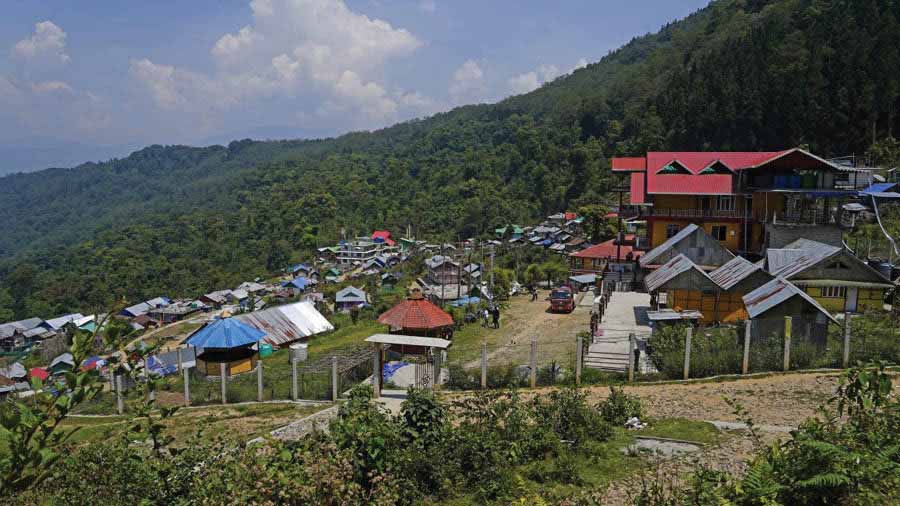
Sillery Gaon is surrounded by dense forest
However, some travellers, bypassing Pedong, opt for a detour just 18 km from Algarah, navigating a secluded road enveloped by pine trees. To their surprise, this path, although not paved and quite rugged, unveils a hidden hamlet that has been a cherished hill retreat for several years.
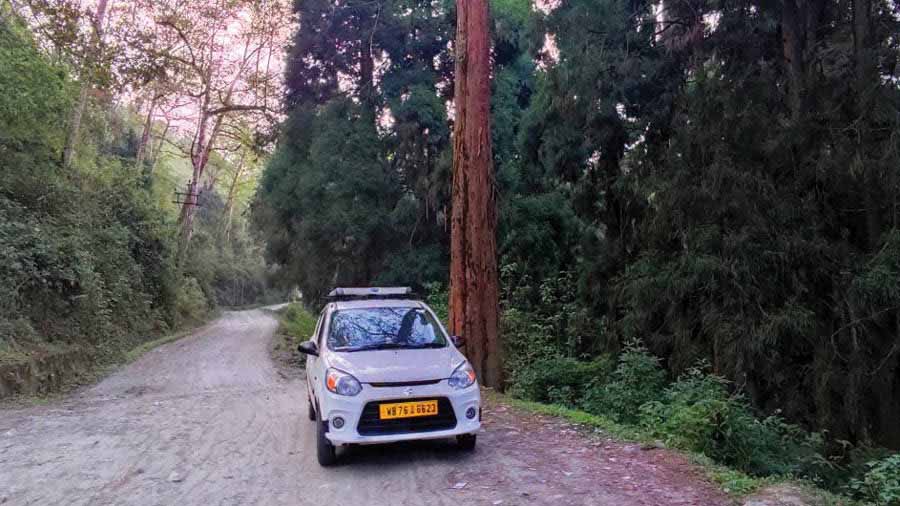
Passing through the bumpy road lined with pine trees to enter Sillery Gaon
The scenic road somewhat soothes the pain of the journey. However, when you reach your destination it seems worth the trouble. Though Sillery Gaon has grown up considerably as a settlement from a hamlet consisting of a few huts some eight years back, yet the natural beauty of the place makes it desirable for solitude lovers.
The village is surrounded by dense forest with a wide view of mountains sometimes covered with layers of clouds. It looks like a drop scene of the theatre presented by nature, as any time that cover of clouds may give way to snow-clad mountains.
After checking in, the best thing one can do is to take a hike on the patches of green in between the pine trees or just walk on the approach road to the village.A segment of this terrain is aptly named Silent Valley, a fitting description as nothing disrupts the serene ambiance except for the melodious chirping of birds.
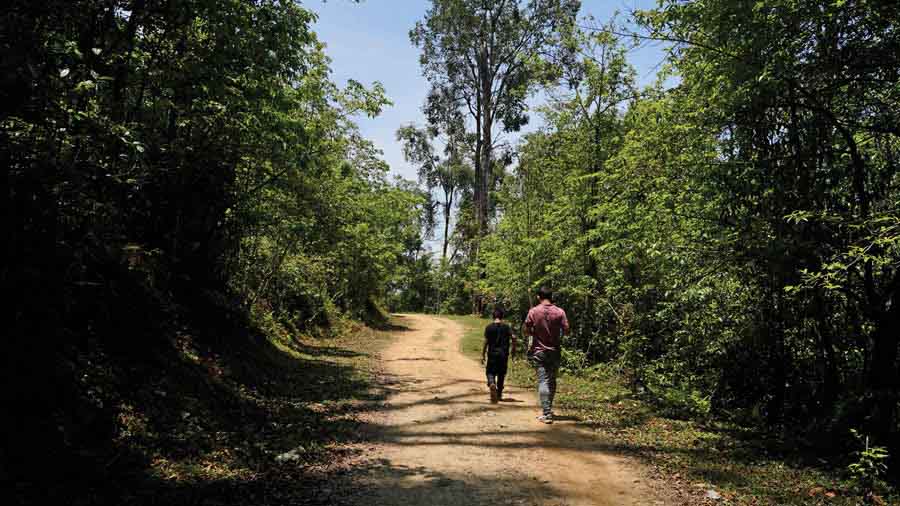
A small hike leads to Ramitey View Point
As night swiftly descends, a common trait in Himalayan hamlets, dinner is typically served between 9 pm and 9,30 pm. Given the unusual speed at which city dwellers like us rarely fall asleep, an ideal post-dinner pursuit is stargazing. The expansive horizon before you, framed by mountains, provides a captivating backdrop for this celestial activity.
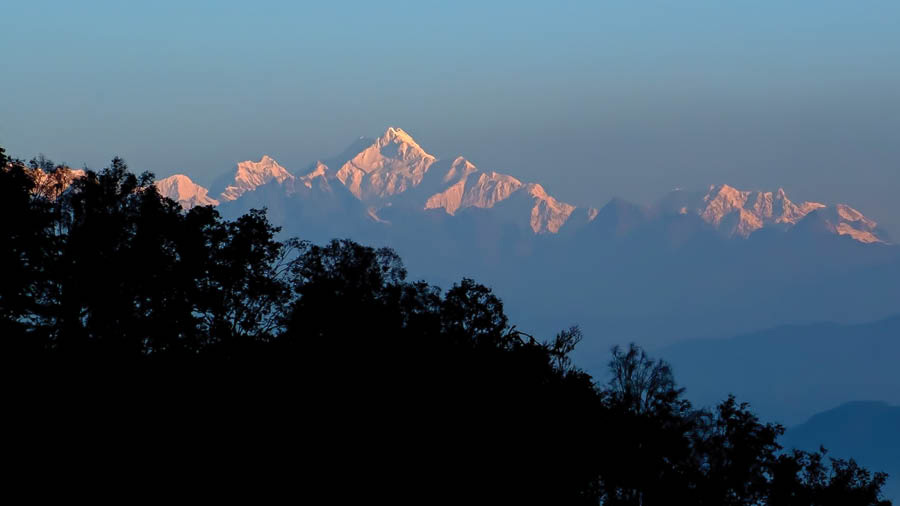
Mount Kanchendzonga range looks different from as seen at Kalimpong as it in the distant horizon with trees in the front and you need a zoom lens for close view Soumya Bandopadhyay
In the morning, if fortune smiles upon you, the rooms afford a breathtaking view of the Mt. Kanchendzonga ranges. The perspective is unique compared to the vistas of Kalimpong or Darjeeling, positioned on a distant horizon with trees in the foreground. For a closer look, a zoom lens proves beneficial, or venture to a nearby viewpoint to witness a mesmerising 180-degree panorama, unveiling the awe-inspiring snow-clad peaks.
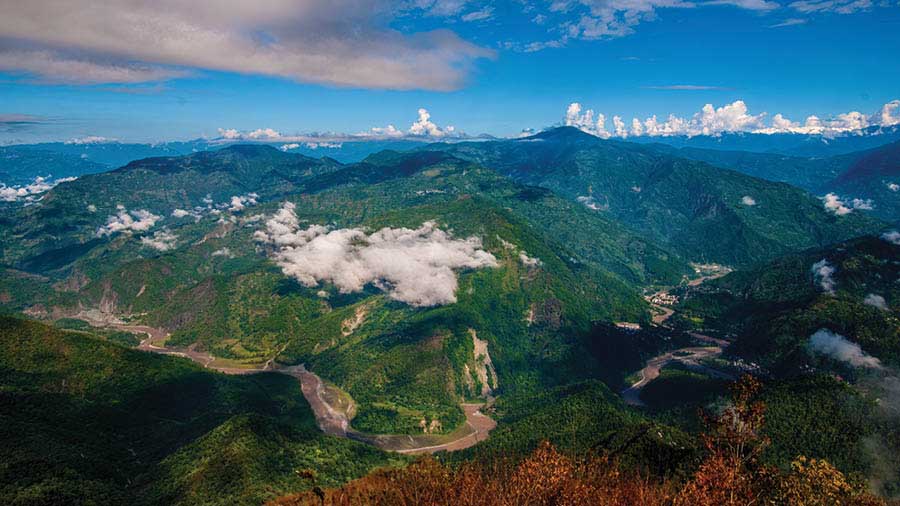
Ramitey View point offers the longest view of river Teesta. On a clear day the entire region from Teesta Bazar to Majhitar in Sikkim is clearly visible Argha Guha
Sillery Gaon is a place to relax and let go of your inhibitiotistans without making an agenda. The best thing one can do is take long hikes through the path in the jungle. One notable route leads to the Ramitey Viewpoint, boasting the longest view of the Teesta River. On clear days, the entire stretch from Teesta Bazar to Majitar in Sikkim unfolds before your eyes.
For enthusiasts of jungle exploration, a compelling option is a visit to the remnants of Dâmsâng Fort, necessitating an uphill trek through a dense forest. Given the intricate detours along the path, securing the services of a local guide is prudent. Positioned at an elevation of 6,300 ft on Kalimpong-Rishi road, this 17th-century fort was strategically established to vigilantly surveil intruders from all directions.
A.R. Foning – a prominent Lepcha activist mentions in his book — Lepcha, my vanishing tribe (1987) that Lepcha ruler Pano Gaeboo Aachyok had his capital or headquarters at Dâling (Dalim) Fort near Gorubathan, and another, a subsidiary one, the Tamsang or the Dâmsâng Fort, in the hills near Pedong.
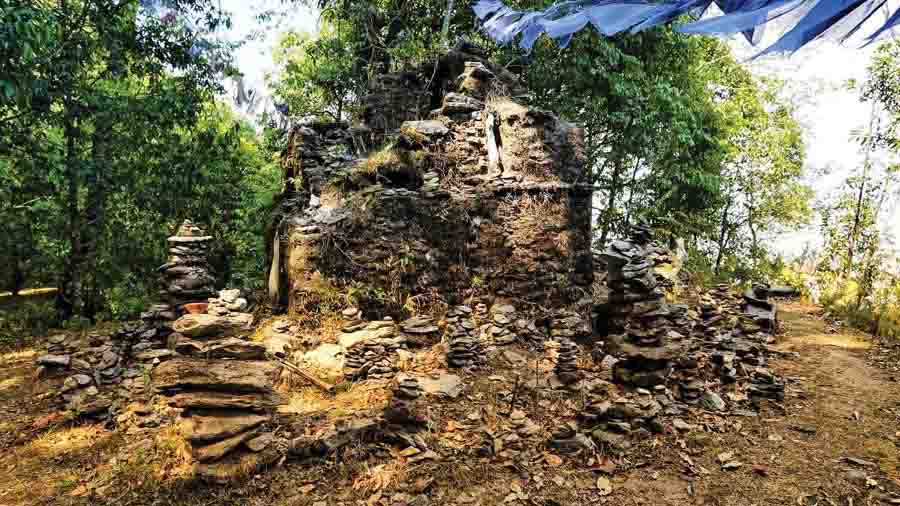
The ruined stone structure inside Dâmsâng fort which was seat for Lepcha king Pano Gaeboo Aachyok
In his book Lepcha Folklore and Folk Songs (2008), L.S.Tamsang mentions that “Dâmsâng was an independent country ruled by Pano Gaeboo Aachyok and his forefathers. After the death of Pano Gaeboo Achyok, Dâmsâng was annexed by Bhutan until 1865 when the British defeated the Bhutanese at Dâling Fort, Dâmsâng, and annexed it into British India”. As per the name of the fort and the region, the Lepchas residing in this region even today are known as Damsang Moo.

The jungle pathway to reach the Dâmsâng Fort
Under the tranquil canopy of ancient towering pine trees, the hiking trail guides visitors to the sacred ruins of the fort. Secluded from the bustle, the site holds profound significance for the Lepchas, who frequent it on various occasions. Guided tours often highlight a dilapidated brick structure, reputedly the throne or durbar area where the Lepcha King once dispensed judgments. Scattered across the ground are sizable rectangular stones, believed to be graves. Recognising its historical importance, the West Bengal Heritage Commission has designated the fort area as a heritage site, marked by informative signboards.
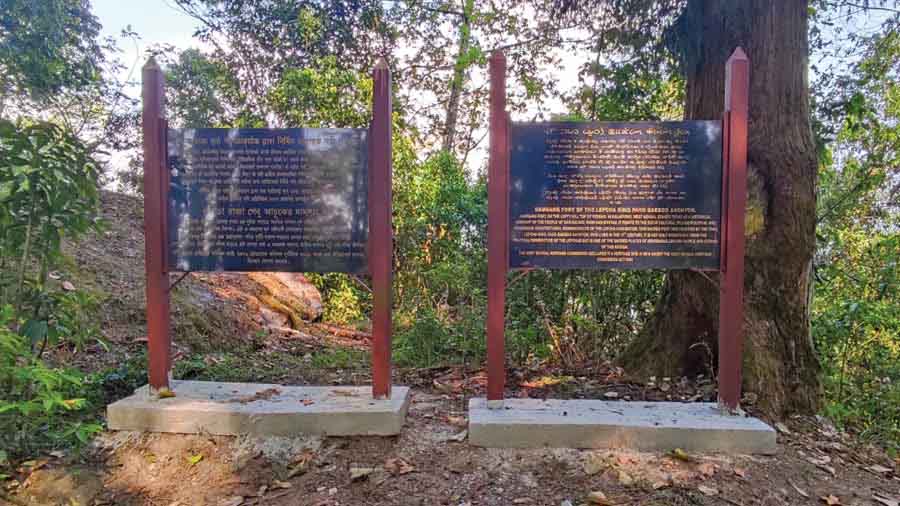
Signboards put up by the West Bengal Heritage Commission inside Dâmsâng fort
The entire ambiance evokes memories of ‘Bhanumati’, the tribal king’s daughter depicted in Bibhutibhsuan Bandopadhyay’s monumental novel Aranyak. Her character serves as a poignant reminder of a bygone era when they were the rulers of the jungle, even though they have long since lost their ancestral forest land.
It is advisable not to hike in the forest in the evening. Tourists may visit Sillery Gaon for the weekend or as a part of the Silk Route tour.
Travel information:
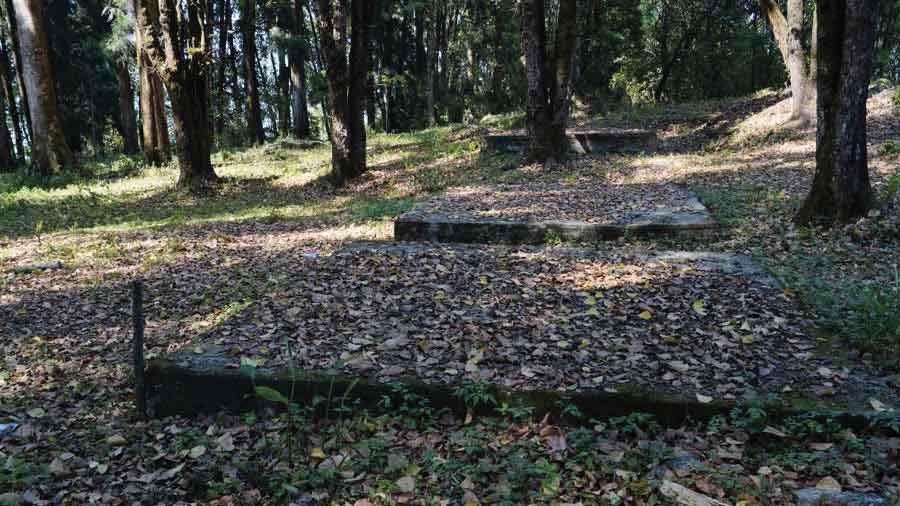
Stone slabs on the ground inside Dâmsâng fort premises
How to Go: Drive in a hired car from Siliguri via Teesta bazaar and Kalimpong followed by Algarah to reach Sillery Gaon. Alternatively reach Kalimpong and hop on to a shared vehicle heading towards Pedong. Ask your host to pick you up from the entry path to the village.
Where to stay and eat: Sillery Gaon has quite a number of accommodation facilities. To choose between them as per budget or to plan for a total Silk Route tour one may contact Call Offbeat Weekend at 9874216054/ 8017412587

